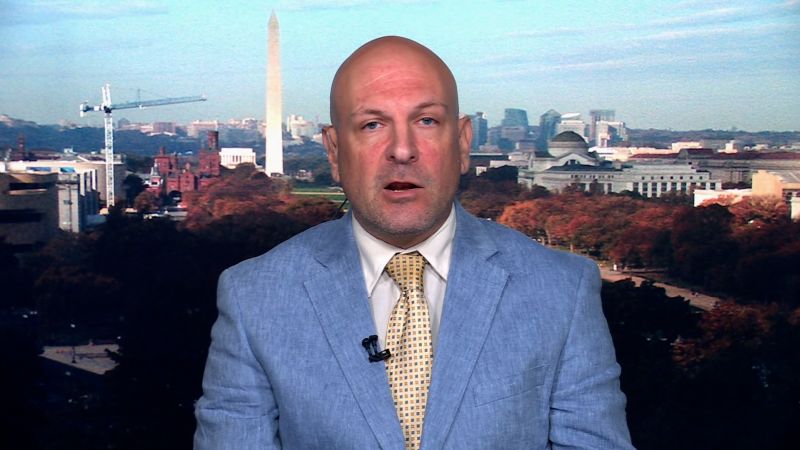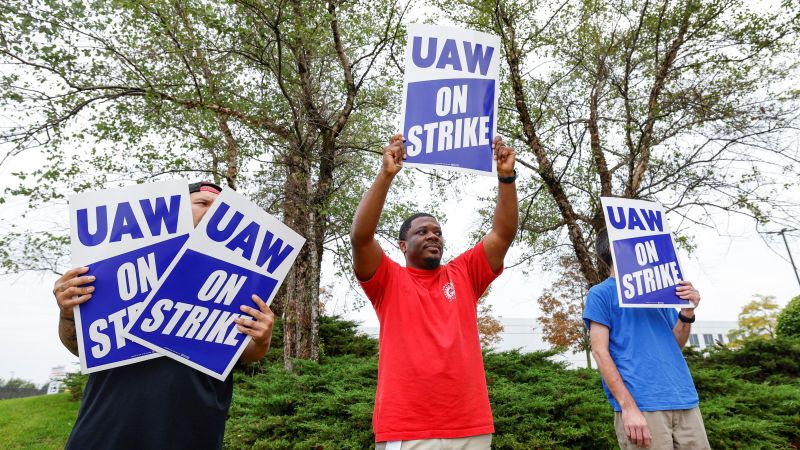Eagle Bancorp, Inc. (NASDAQ:EGBN) Q3 2023 Earnings Conference Call October 26, 2023 10:00 AM ET
Company Participants
Charles Levingston – Chief Financial Officer
Susan Riel – President and Chief Executive Officer
Janice Williams – Chief Credit Officer
Conference Call Participants
Catherine Mealor – KBW
Casey Whitman – Piper Sandler
Operator
Good day, and thank you for standing by. Welcome to the Eagle Bancorp Third Quarter 2023 Earnings Conference Call. At this time, all participants are in a listen-only mode. After the speakers’ presentation, there will be a question-and-answer session. [Operator Instructions]
I’d now like to hand the conference over to your speaker today, Charles Levingston, Chief Financial Officer of Eagle Bank. Please go ahead.
Charles Levingston
Thank you, Liz. Good morning. This is Charles Levingston, Chief Financial Officer of Eagle Bank. Before we begin the presentation, I would like to remind everyone that some of the comments made during this call may be considered forward-looking statements. We cannot make any promises about future performance, and it is our policy not to establish with the markets any formal guidance with respect to earnings. None of the forward-looking statements made during this call should be interpreted as our providing formal guidance.
Our Form 10-K for the 2022 fiscal year and 10-Q for the June 30, 2023 and current reports for Form 8-K — or on Form 8-K identify certain risk factors that could cause the company’s actual results to differ materially from those projected in any forward-looking statements made this morning. Eagle Bancorp does not undertake to update any forward-looking statements as a result of new information or future events or developments unless required by law.
This morning’s commentary will include non-GAAP financial information. The earnings release, which is posted in the Investor Relations section of our website and filed with the SEC, contains reconciliations of this information to the most directly comparable GAAP information. Our periodic reports are available from the company online at our website or on the SEC’s website.
I would now like to turn it over to our President and CEO, Susan Riel.
Susan Riel
Thank you, Charles. Good morning, everyone. Before we start, I would like to welcome Eric Newell as the new member of our senior management team and as CFO of Eagle Bancorp. Adding Eric to our finance team gives us more talent and a deeper bench and enables us to accomplish our long-term goals to continue to serve and support our customers and build value for our shareholders.
As Eric joined us late in the quarter, we will follow our normal format today with Jan discussing her thoughts on the local economy, loans, reserves and credit quality matters, and then Charles return to discuss our financials in more detail. At the end, the three of us and Eric will be available to take questions.
I am pleased that our third quarter performance continued to build on the progress we are making in an uncertain operating environment. During the third quarter, we saw a stabilization of both earnings and margins and an improvement in the funding mix with deposit inflows and pay downs of short-term debt.
On the deposit front, we are working diligently to build capabilities to drive growth in our core deposit base. We have a multi-pronged approach to build out a scalable and sustainable deposit growth strategy. I will highlight three areas of focus for the EagleBank team. First, enhancing our treasury management program and product suite will assist us in building and maintaining C&I relationships.
Next, we are working to enhance our digital banking platform allowing us to leverage our in-footprint brand and increase our market share of deposits in the DMV region, as well as develop opportunities to augment deposit growth outside of our footprint.
Finally, we are looking at ways to better leverage our existing branch network to drive customer acquisition and exploring how to increase EagleBank’s physical presence in lower-cost geographies contiguous to the Washington DC metro market.
With these initiatives, I’m excited about the future of EagleBank’s ability to grow and improve the deposit mix. This will continue to — this will contribute to the progress we’ve made in repositioning our balance sheet to meet the challenges of today’s high rate environment. In addition to the larger initiatives that I have highlighted, there are many other smaller initiatives we are working on as a team.
On the other side of the balance sheet, we are also keeping our focus on asset quality. We have a proven history of superior asset quality and conservative underwriting that has worked well for us in times of market stress. We have pulled together special expert teams to assess our office and multifamily exposures. We are confident that the approach our teams are taking will put EagleBank and our borrowers in the best position in light of a difficult operating and interest rate environment.
Before turning it over to Jan, I want to add that I’m excited about the hiring of Karen Buck, our new Chief Administrative Officer, who will be instrumental in providing leadership and guidance through the execution of these strategies.
With that, I’ll hand it over to Jan.
Janice Williams
Thank you, Susan and good morning everyone. The Washington DC market area continues to be a source of economic strength. Even with the local government workers not yet returning to the office in great numbers. The unemployment rate in the Washington Metropolitan Statistical Area rose to 2.9% in August, up from 2.7% in May. This mirrors the change in the nationwide figure which grew from 3.8% in September, up from 3.6% in June. This strength in the Washington area market can be seen in our asset quality metrics.
Non-performing assets or $72 million, which was 65 basis points of total assets. The increase of $41.4 million was primarily from one multifamily credit for $39.5 million, which we discussed as a past due last quarter. There were three charge-offs for the quarter totaling 467,000. All three were SBA loans. The total net charge-offs for the quarter was 340,000.
Loans 30 days to 89 days due were $46.5 million, up from $41 million at the end of the prior quarter. The increase from the prior quarter was primarily from one office property in Northern Virginia and one assisted living facility in Maryland, offset by the migration of the previously mentioned multifamily credit moving to nonperforming status.
For the third quarter, we had a provision to the ACL of $5.6 million. This was somewhat higher than the provision last quarter that even with the three charge-offs and higher loan balances, our ACL to loans at quarter end was up 5 basis points to 1.05%. The provision for unfunded commitments had a reversal. This was primarily from a reduction in unfunded commitments as construction projects were funded and added to our quarter end loan balances.
With regards to the higher ACL provision, It was primarily driven by increases in qualitative reserves, combined with a smaller increase in the quantitative reserve. The increase in qualitative reserves was driven by increases in early stage past dues and overall perceived weakness in the commercial real estate market. The increase in quantitative reserve was primarily due to loan growth during the quarter, particularly in longer life categories that carry corresponding higher reserves, as well as slowing prepayment speeds in certain loan categories, due to higher interest rates, partly offset by modest improvements in the unemployment forecast.
Focusing on CRE Office loans secured by non-owner occupied credits. These loans where $950 million or 12% of the loan portfolio at quarter end, down $26 million from the prior quarter. These office properties are primarily located in the Washington DC market, with 24% in the District of Columbia, 34% in the Maryland suburbs and 34% in Northern Virginia and an additional 7.6% located outside of these markets.
We did not have any outstanding commercial real estate office construction loans at the end of the third quarter. To monitor our income producing CRE credits, we continue to be proactive in reaching out to commercial clients well in advance of maturities to better understand the headwinds that their properties could be facing including a significantly higher interest rate environment and work collaboratively to achieve results beneficial to both the Bank and the borrower.
Overall in terms of credit underwriting, we remain cautious and we will continue to exercise selectivity and to apply our customary strong underwriting standards. Having said that, we see opportunities to continue to add high-quality commercial loans to the portfolio, and to maintain our portfolio as other loans run off.
With that I’d like to turn it over to Charles.
Charles Levingston
Thanks, Jan. This was another good quarter and that we were able to improve our funding mix, one of our strategic goals. During the quarter, our efforts to gather deposits organically met with success as deposits increased by $658 million. This increase was led by savings and money market accounts, up $339 million and time deposits up $255 million.
At the same time broker deposits declined by $38 million and were down to 29.6% of deposits. With deposits up $658 million we took the opportunity to reduce our higher cost borrowings by paying down 100% of our FHLB advances. BTFP borrowings, which have a more attractive rate and collateral requirements remain unchanged.
On the balance sheet, our mix of deposits and borrowings at quarter-end is now much closer to how it looked at the end of December before the market disruption in March. During the quarter, deposits climbed to $8.4 billion, compared to $8.7 billion at the end of 2022. And short-term borrowings were reduced to $1.3 billion, compared to $975 million at year-end.
One item, though, that continues to change is the move by deposit customers into interest bearing accounts. For the quarter, average non-interest-bearing deposits were down $310 million or 12.1%, and interest-bearing deposits were up $742 million or 12.5% of a much bigger base. For the quarter, average non-interest bearing deposits were 25% of deposits down from 30% the prior quarter.
Customers seeking out higher interest bearing accounts and a rate increase across most of all our product lines at the end of July shortly after the Fed raised rates by 25 basis points combined to increase our cost of funds by 19 basis points to 3.39%. This is a much lower increase than the prior quarter’s increase of 58 basis points.
As we are talking about cost of funds, I’ll continue with commentary on our margin. This quarter net interest income was down $1.1 million and the net interest margin was 2.43%, down 6 basis points. Interest income was adversely impacted by a reversal of $1.6 million because of the one multifamily loan in the District of Columbia entering nonperforming status in the quarter. This reversal reduced our margin by 6 basis points and accounts for all the change from the prior quarter.
Before moving on to the income statement, we experienced loan growth this quarter with loans up $150 million. But some of that was timing of existing construction loans funding at quarter end. This was the reason for the reversal of the provision on unfunded commitments. Even with the increase in loans, the strong growth in deposits drove our loan to deposit ratio down to 95% from 101% the prior quarter.
Looking at the bottom line, net income was $27.4 million for the quarter compared to $28.7 million in the prior quarter. This stabilization of earnings is a result of our targeted efforts to improve the balance sheet mix, reduce the rate of expense growth and maintain our strong asset quality metrics, which are reflected in the provision for credit losses.
Additionally, as we mentioned last quarter, there was a lag in Fed rate changes impacting interest income on loans as compared to interest expense on deposits. As the Fed has slowed the pace of rate increases, the benefit from the variable-rate loans resetting higher and from new loans at market rates is beginning to reduce the gap versus Interest expense changes.
Other items impacting the quarter-over-quarter earnings were noninterest income, which was down primarily because the prior quarter included non-recurring income of $2.8 million from an SBIC fund.
And non-interest expense showed improvement down $345,000 from the prior quarter primarily due to lower overall expenses offset by higher FDIC fees, which were up $761,000 from the prior quarter on higher assessment fees. In regards to expenses, we have always prided ourselves on being highly efficient and we aim to continue to operate in that manner.
We recognize that we will need to invest in the company over the next several quarters to achieve our strategic goals. But we do not expect a meaningful increase in the run rate of expenses in 2024, due to cost savings we’ve realized year-to-date. This past quarter efficiency was 48.8%, which compares well to our proxy peers.
Lastly, capital remains a core strength of the company. Our tangible common equity ratio at quarter end was 10.04%, which was higher than all but one of our proxy peers last quarter. And in terms of liquidity, we improved our aggregate borrowing capacity to $2.26 billion, which gives us the financial flexibility to provide the support and services our customers expect.
With that, I’ll hand it back to Susan for a short wrap up. Susan?
Susan Riel
Thanks, Charl. So we are all excited about EagleBank’s future. We have demonstrated our ability to improve the balance sheet and stabilize both earnings and margin. We also continue to meet our commitment to a relationship first culture, strong conservative underwriting and peer-leading efficiency.
And last but certainly not least, the recent additions to our leadership team gives us added depth and expertise to meet and succeed at meeting today’s challenges. In closing, our senior management team would like to thank all of our employees who work hard every day to make Eagle the success it is.
With that, we will now open up for questions.
Question-and-Answer Session
Operator
[Operator Instructions] Our first question comes from the line of Catherine Mealor with KBW.
Catherine Mealor
Thanks, good morning.
Janice Williams
Hey, Good morning.
Catherine Mealor
I will start with credit. Jan, I remember last quarter you talked about — I think it was something in the range of like $200 million of office loans that were maturing in the next 18 months and you were — or maybe it was like $400, but then $200 you were looking at this quarter in some kind of capacity. Can you just give us an update on what that process looks like? And any kind of update in your office portfolio today versus last quarter? Thanks.
Janice Williams
Sure. We worked through about $120 million in office loans in the past quarter with longer-term extensions. These are loans that really were going to be seeing more extensions on, I think, as there really is no market right now for office refinance. So what we’re doing is working with each particular building, sponsor, guarantors. Each one is, to a certain extent, unique. We are exploring the continued uses of office and also alternative uses.
I think we’ve been pretty successful in moving forward with that. That doesn’t mean that we won’t have more nonperforming loans in the future. But I think based on the underwriting that we did initially, we have a fairly large amount of room for — to absorb declines and valuations. So I’m not anticipating that we’re going to see significant charge-offs in that office sector right now. And we’re going to continue to work with customers and process extensions as merited and when in the best interest of the bank and the borrower.
Charles Levingston
Okay. Okay, great, that’s very helpful. And then it was nice to see a stability in the special mention and substandard categories. Can you remind us how much of your substandard loans are office?
Janice Williams
I can. In the substandard category, we have $74 million. In the non-performing category, we have $23 million. Special mention, we have $85 million. Watch, we have $55 million.
Catherine Mealor
Okay, great, thank you. And then moving over to the margin. It was great to see the increase in total deposits, but you were still seeing a decline in the non-interest-bearing category. But can you talk about anecdotes or kind of trends of what you’re seeing within that shift in your customer base? And as you just — I know it’s so hard to forecast. But as you kind of sit here today, what’s your gut on where you think those balances or that mix shift will bottom?
Charles Levingston
Yes, sure. Obviously, we’ve had a long history of being able to maintain non- interest-bearing deposits around 30%. We’re clearly in a very different environment these days with rates where they are. And some of the disintermediation that we’ve seen over the last 18 months or so has been just that these folks not wanting to sit on idle cash and have that cash earning for them.
My observation is most of that migration. If you just look at average, average balances quarter-over-quarter has moved into term deposits. And that kind of lends itself to this notion of the Fed staying higher for longer, but also people wanting to capture the yields on those. My sense is that we have a very solid base of non-interest-bearing deposits here, I would expect us to maintain around where we are.
And at the same time, as Susan mentioned earlier in her remarks, there will be continued efforts to build out treasury management services in order to attract additional operating accounts and to continue to pour more in as maybe we see some migrating and looking for some yield there. But my expectation is we’re in a pretty happy place with where those are in terms of the baseline.
Catherine Mealor
Okay, all right, great. And actually if I could go back to the office, I forgot one thing I wanted to ask, did you — was part of the increase in the ACL associated with your office book? And can you remind us what your office reserve is today?
Janice Williams
We did have some portion of the reserve that was associated with the office portfolio, although we have no impairment reserves on the office portfolio right now. So I think a portion of the increase was associated with that to the extent that a loan would move from performing to non-performing. Obviously, if it’s not impaired, the reserve that was associated with that would go away.
I think our feeling about the market in general and our office overlay provides us some buffer there. We have, in terms of substandard loans, the reserve is about 6% of the substandard loans that’s allocable to office, and we have about 3% on the special mention. Watch is about one in three quarters, and then the past portfolio is 130.
Catherine Mealor
Okay. Really helpful. Thank you, Jan. Appreciate it.
Operator
Our next question comes from the line of Casey Whitman with Piper Sandler.
Casey Whitman
Hey, good morning.
Charles Levingston
Good morning, Casey.
Janice Williams
Good morning, Casey.
Casey Whitman
Just sticking with credit, maybe can we address the two loans that moved to past due this quarter. Can we talk about just the size of each of the loans and then any other details you can give us Jan around those two in terms of LTVs or any specific reserves you might have on them or any details on those two would be helpful. Thank you.
Janice Williams
Sure. They are both real estate secured. The nursing home assisted living facility is owner occupied. So that was not part of our CRE portfolio. Based on a current appraisal, it’s not an impaired loan, so there would not be an associated impairment reserve that would go with that. There’s also on the office side, that loan they’re each about $20 million. On the office side, that loan was in the process of having an extension done. It was extended for a year. And based on the appraisal that was done in December of 2022, there is no impairment.
Casey Whitman
Okay. All right, thank you. Susan, I wanted you to address some of your — I think in your prepared remarks, you talked about just potentially expanding outside the DMV. Can you talk about some of the markets that might make sense for you? And would that start with building out more of a branch network or just hiring lenders or sort of what’s the broader strategy and how long might this take to execute?
Susan Riel
We — Casey, we’re still flushing some of that out, but we still will maintain our brand slight strategy but looking at some contiguous areas on what they may bring as far as opportunities for branch deposit growth and potentially loan production also. So we will take all of that into consideration as we explore those opportunities. But we are open to that.
Casey Whitman
Okay. Stay tuned. Back to you, Jan. Just one more credit question, just can you address your share of national credit exposure. What kind of syndications you have?
Janice Williams
It’s pretty minimal. We only have a couple of loans there. The largest one is part of the Wharf complex, and that’s performing well, it’s actually done very well this year. It is rated by the national team as special mention. So that’s how it shows up on our books. When that rating changes, we will change it on our books as well. But that’s been a pretty successful project in the D.C. area. And we also have a piece of a deal that is casino-related in New England, and that’s doing quite well and is in the past portfolio.
Casey Whitman
Okay, thank you.
Operator
That concludes today’s question-and-answer session. I’d like to turn the call back to Susan Riel for closing remarks.
Susan Riel
Thank you, everyone. We appreciate your questions and you taking the time to join us on the call today. And we look forward to speaking with you again next quarter. Have a great day.
Operator
This concludes today’s conference call. Thank you for participating. You may now disconnect.
Read the full article here






